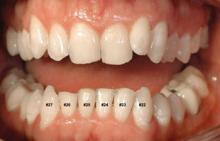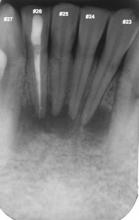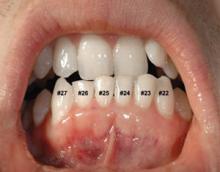Oral habits such as bruxism—compulsive grinding or clenching of the teeth—can be a manifestation of obsessive-compulsive disorder (OCD) and other anxiety disorders.1 Bruxism also may be a side effect of selective serotonin reuptake inhibitors (SSRIs)2,3 used to treat OCD4 and depression. Other oral conditions can complicate treatment of these disorders (Table 1).
Potentially serious sequelae of bruxism and similar behaviors include:
- wearing down of teeth (more common)
- necrosis of the pulpal tissues that results in non-vital teeth (less common).
The following case underlines the need for early referral to a dentist and close follow-up for patients who have tooth-related behaviors or are taking medications associated with a risk for such behaviors.
Table 1
Oral conditions associated with anxiety disorders and depression
| Bruxism |
| Canker sores |
| Dry mouth |
| Temporomandibular joint disorders |
| Lichen planus (redness or mouth ulcers) |
| Non-vital teeth |
| Tooth wear, fracture |
CASE REPORT: A compulsive oral habit
Mr. G, age 26, presents to our school of dental medicine with the chief complaint that he needs a crown. On clinical intraoral examination, we find he has multiple restorations, some areas of recurrent tooth decay, and a fractured cusp on a maxillary molar. His mandibular incisors show greater wear on their incisal surfaces than would be expected for a patient his age. This is especially true of his mandibular right lateral incisor (tooth #26) and canine (tooth #27) (Photo 1).
Clinical examination also reveals a restoration on tooth #26 that was consistent with an access cavity drilled for endodontic (root canal) therapy (Photo 2). This finding is consistent with his dental history. Soft tissue examination is within normal limits. He reports that he saw a dentist 7 months earlier but could not afford the fees.
During his medical history, Mr. G states he has mild Tourette’s syndrome that was diagnosed when he was 10. In the early 1990s he tried several medications, including haloperidol and pimozide, as a subject in research studies of Tourette’s. He could not recall the dosages of the medications or for how long he took them. Because these medications did not improve his symptoms, he stopped taking them after the studies ended.
Photo 1 Unexpected tooth wear: A clue to an anxiety-related oral habit
Teeth of a 26-year-old man show greater than expected wear, particularly on the mandibular right lateral incisor (tooth #26) and canine (tooth #27).
Photo 2 Radiographic evidence of tooth non-vitality
Radiolucencies (dark areas) in the bone at the apices of the tooth roots are a radiographic sign of non-vitality. Tooth #26 has undergone root canal.Mr. G reports that when he was in second grade, a psychiatrist diagnosed him with OCD, and has received treatment since then. We observe that while Mr. G is seated, he continually raises his right arm above his head and rubs his fingers together. He reports and demonstrates numerous other compulsive rituals, including head movements and rubbing his elbows against his side. His right elbow has a large scab.
He has been taking sertraline, 150 mg/d, for the past month. He says his psychiatrist prescribed this medication to help him break out of what he describes as episodes where he “gets into a mental loop.” Sertraline has improved Mr. G’s symptoms but they have not resolved.
He further reports that he has begun to “grind” his anterior teeth. Technically, he does not engage in grinding or bruxing; he has a habit of pushing his mandible forward so that his mandibular (lower) teeth are anterior to the maxillary (top) teeth, then forcefully pulling his mandible back so that the lingual (back) surfaces of the mandibular incisors push up against the buccal (outside) surfaces of the maxillary incisors (Photo 3). He states that he engaged in this habit frequently from approximately age 19 to 22. When Mr. G was 22, his dentist reduced the height of tooth #23, which Mr. G says he used “to set things in motion.” The dentist’s maneuver cut down but did not eliminate Mr. G’s habit.
Mr. G had not complained of nor had any clinician asked him about his bruxism-like behavior. He noted that the oral habit began prior to sertraline treatment, thus suggesting no relationship between the medication and the behavior. Interestingly, although some studies have reported bruxism as a side effect of SSRIs,2,3 at least 1 case report found that SSRIs reduced nocturnal bruxism.12
Photo 3 Obsessive-compulsive disorder manifested in Mr. G’s oral habit




